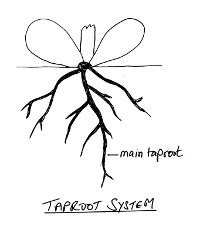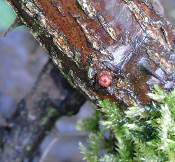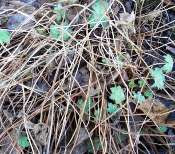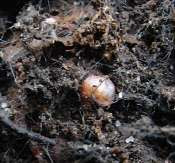Strange how seeds germinate and grow in the wild as if by magic, even in seemingly impossible conditions, yet not when our two penneth is involved. And it's not just because we're growing them inside. If ever you have spilled a few grass seeds between the flags whilst seeding a lawn, you will known what I am talkling about. Why is it that grass seeds are so difficult to grow on a lawn (at least for me), where one would assume they have everything they need, whilst they never fail to grow between the flags, devoid of water and soil? I don't know - another one of those growing mysteries. But seriously, how can we improve our competence in this area? How can we germinate seeds more successfully?
UNDERSTANDING THE PROCESS
We have already looked at the
structure of seeds and have seen that they are very-much-alive embryo plants complete with root, stem and leaf; yet amazingly these same seeds are able to maintain themselves in this state for long periods of time. How do they do this, and why?
SURVIVING THE WORST
Seeds are the way the Gymnosperms and Angiosperms (flowering plants) increase their presence whilst surviving conditions too severe and/or too restricted for normal growth. These might be climatic such as drought or frost; or they might be physical such as fire or flood; or they might involve other factors such as light quality, or soil condition, or competition.
Over millions of years, plants have adapted to survive the worst (and also to anticipate the worst, but that's another story). They have squared the circle by creating a form - the seed - in which they are very much alive yet apparently dead (didn't I always say they were clever?). The seed represents the DORMANT stage of a plant's life cycle. This is how they do it.
A HARD COAT AND A PARCHED THROAT
As seeds mature they lose water and develop a hard coat.
Drying down to about 14% greatly reduces cell respiration: that process which is essential to all life. And this allows the embryo to use less of the food store from the seed, thus increasing its survival potential.
The seed coat keeps out water and air, to maintain the dormant state. Often hormones (growth substances) are also involved. Abscisic acid (ABA) both induces and maintains dormancy. Another hormone, gibberellic acid, works the other way; it is often used commercially to break dormancy.
OTHER PROCESSES
It is hard to believe that a seemingly dead and insignificant seed can be constantly monitoring the light in terms of intensity, colour and duration. Yet it does (See
'Should We Dig In The Dark?'). Furthermore, it also monitors the level of carbon dioxide around it . . . And also the amount and type of nutrients . . . soil acidity . . . And . . so on. Seeds really are deceivingly complex little critters.
WHY DOES IT DO ALL THIS?
All the above is used by the seed to begin its growth journey from the right position, in the right soil, at the right time of year . . . etc . . . to give it the best chance of survival. After all, it only gets one chance. If it messes up, that's it: instant death; that's why there are so many seeds. We can learn a lot here: If we become familiar with a seed's natural environment, we can usually be successful by emulating them. This is the secret to propagating difficult seeds.
READ THE PACKET
However, whilst plant dormancy is a fascinating study, it is far too diverse and complex to go into here. Fortunately, as mere ordinary growers we only need to know a few essentials. This is because most of the seeds we sow in our pots, containers, and even in our gardens, will come out of their dormant state and commence active growth simply by supplying water, air and the correct amount of warmth. Oh, and I should add another factor: light.
And, before I forget, there is something which is vital to success, something which no one ever seems to consider mentioning: READING THE PACKET and FOLLOWING ITS INSTRUCTIONS - to the letter, if possible. This way, any little quirks the seeds might have will be catered for. However, having said this, it is surprising how much packets differ in instructions, even over quite significant things. For example, I was instructed (by the packet) to cover the basil seeds last year, only to discover from a reliable source that they should not be covered, just pushed into the compost (at last, an excuse!)
THE GERMINATION PROCESS IN DICOTS
As the dry seed imbibes water, the enzymes within it wake up and begin to work upon the food stores (oils, starches or proteins) and mobilise them to produce fuel for new growth. Rapid swelling occurs at this stage and the contents of the seed burst through the seed coat, starting with the root (the radicle). Using the food reserves, it is essential to access and secure a water supply.
After this, the shoot (plumule) stretches upward, often dragging the cotyledons (which now have taken the form of seed leave(s)) behind it. Arching and dragging in this way prevents damage to the tender new leaves.
The new plant uses phytochrome to determine light intensity. If it is too low (as it would be if surrounded by other plants), the hormone gibberellic acid is produced which induces stretching (
etiolation) until sufficient light is available. The leaves remain small at this stage to waste as little food as possible, and only develop further once sufficient light is reached. At this time, the leaves begin to photosynthesise and produce food to fuel further growth. It is essential this stage is reached as soon as possible.
NOW . . . AT LAST . . . HOW TO SOW SEEDS
THE PERFECT SCENARIO
As growers, we need to think of ways to supply enough water at sowing for the seeds to imbibe and start growing, then provide an ideal environment in terms of water/air mix, temperature, light, and nutrient levels.
We are often told to soak trays of compost with water AFTER sowing seeds. Whilst I cannot say this is wrong, it is nevertheless where most novices go wrong. And the reasons are obvious:
From what we have just seen, soaking only satisfies the first part of seed growth - that of imbibing water. It is only necessary to begin the process. Furthermore, it tends to disturb the freshly-sown seeds too much, leaving some exposed and others at different depths, and therefore at differing light and carbon dioxide concentrations. Not a good start.
I would advise to soak, then drain the compost, but BEFORE the seeds are sown. After levelling and light tamping, the seeds can then be sown, and covered if necessary (read the packet) with fine dry compost shaken evenly from an empty plant pot, or similar.
As the water gradually soaks down under gravity, it will pull oxygen (vital for growth) into the surface to replace it. Combined with the water lost through evaporation, this will work wonders for the seeds, and in my opinion should be all that is necessary. However, some growers mix their seeds with a fine layer of sharp sand, or perlite or vermiculite. All this helps keep the seeds moist whilst avoiding drowning and thus causing the onset of fungal diseases such as 'pythium' or 'phytophthora' which cause damping off.
It doesn't matter how much water is in the compost BELOW the seeds, since the developing root need not enter it. It can stop growing once reached, then follow the level down as this water is removed.
APPLY NO FURTHER WATER
Clearly, if further water is applied too soon, it will occupy the pore space around the seed and thus remove its vital supply of oxygen.
Most novice growers, not realising any of this, apply water too soon and drown the seeds. For some reason, we have all been conditioned to believe that roots need to be immersed in water. It must be those bean and pea seeds we grew in jam jars at school. No matter. Whatever the cause, we would all do well to read and digest the above. Success with seeds should then be possible.
WHAT ABOUT COVERING?
Here we go again. Can I just say, there is one truth which all growers should have framed and hung above their bed:
DISEASE LOVES EXCESS HUMIDITY.
This is the cause, in some way or other, of almost all plant problems - at least as far as the novice is concerned.
I am a dry grower and avoid covering anything if at all possible, no matter what the gardening books might recommend. Needless to say, after soaking seed compost with water, as described earlier, I do not cover it (many growers cover with a sheet of glass). And I am pleased to say that the technique outlined has been virtually 100% successful. I like to see the top of the compost changing colour. That way I know it is still damp enough underneath but airy enough on the surface.
I know I am using a propagator at the moment (to propagate begonias), but that is only because it was too early to grow most things. You will find more success with seeds if you grow them in natural conditions at a natural time of year. Propagators can be fine, but they also can provide too much humidity and, surprisingly, too much heat. They can also provide a heat which is too even (some plants need a different night and day temperature of at least 5 deg C). Study the germination temperatures on the back of the packet carefully. You will be amazed at how many plants like it cool. Don't be in a hurry. You can't force plants.
COMPOST MIX
Many growers either buy in special seed compost, or mix coarse
sand or perlite or vermiculite into multipurpose. This is a good practice, since it helps aeration and also reduces the nutrient level.
However, this blog is about GROWING AT LEAST COST. It is therefore my intention to show you how to achieve good results with what you have. I have no axe to grind. And you can be sure that I will not look down on you if, for example, you prefer to use your own soil, free from the garden. Indeed, if you look at last year's posts, you will see I did that on several occasions (I am even now using last year's compost and last year's seeds). Even so, I would - for now at least - recommend a good brand of fresh, multi-purpose compost, which we can use for all purposes.
 This over-wintered rose bud is about to break open. Gave a second spray with myclobutanil to kill blackspot spores arriving on new leaves. Blackspot over-winters on both stems and soil.
This over-wintered rose bud is about to break open. Gave a second spray with myclobutanil to kill blackspot spores arriving on new leaves. Blackspot over-winters on both stems and soil.



























